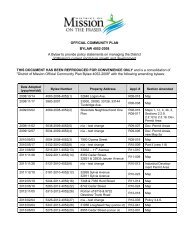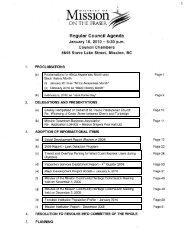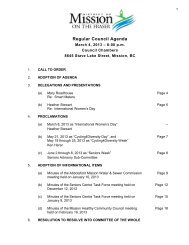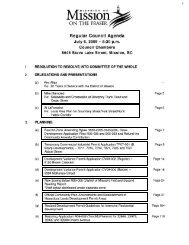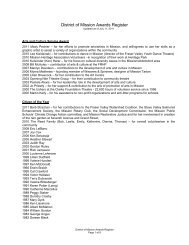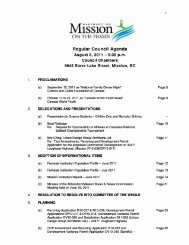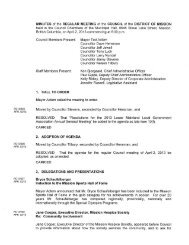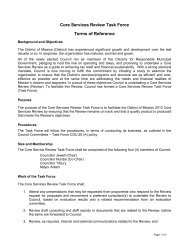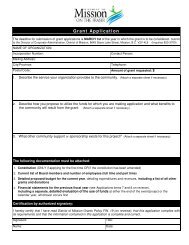June 15, 2009 - District of Mission
June 15, 2009 - District of Mission
June 15, 2009 - District of Mission
You also want an ePaper? Increase the reach of your titles
YUMPU automatically turns print PDFs into web optimized ePapers that Google loves.
64<br />
UMC Report No. 32 -<strong>2009</strong><br />
Page 2 <strong>of</strong> 5<br />
DISCUSSION<br />
The WSC requested staff review the current formula due to the following reasons:<br />
• The formula is currently based on historical flow split, but does not take into account the<br />
future growth <strong>of</strong> the two municipalities. By nature, any Joint Water Capital Project is<br />
initiated to accommodate future growth and is designed based on future growth. The cost<br />
sharing <strong>of</strong> such should therefore also be based on future growth, but not past historical<br />
flow record.<br />
• The formula is currently based on flow split <strong>of</strong> Average Day Demand. However, the Joint<br />
Water Capital upgrades are typically designed based on Peak (or Maximum) Day<br />
Demand (maximum water consumption over 24 hours), which may exhibit a different flow<br />
split between Abbotsford and <strong>Mission</strong>. The cost sharing strategy should therefore be<br />
related to Peak Day Demand, instead <strong>of</strong> Average Day Demand.<br />
Principles<br />
Staff came up with a strategy to cost share Joint Water Capital Projects that would incorporate<br />
the "future growth" and "Peak Day Demand" concepts. This proposed strategy would<br />
accommodate deviations from the projected growth by each municipality.<br />
Key principles <strong>of</strong> the proposed strategy are summarized as follows:<br />
• Only the growth-related portion <strong>of</strong> the Joint Water Capital Projects is proposed to be<br />
shared using this strategy. Non-growth related (e.g. asset replacement, etc) costs would<br />
be shared using the Average Demand Day flow split formula as in the past.<br />
• "Growth" is expressed in terms <strong>of</strong> "Peak Day Demand", or average <strong>of</strong> top 10 Peak Day<br />
Demand days <strong>of</strong> the year (This is still in discussion, and will be further explained later in<br />
the report under "Discussion on Peak Day Demands").<br />
• For each asset, the actual "growth" <strong>of</strong> Abbotsford and <strong>Mission</strong> in percentage will be<br />
compared to the projected "growth" documented in the 2008 Water System Optimization<br />
Study (Associated Engineering) in percentage. Actual "growth" (or "Peak Day Demands")<br />
will be recorded via flow meters at key locations. The projected "growth" will be updated<br />
in each Master Plan, which is to be undertaken every 5 years. The updated projected<br />
"growth" will only affect capital projects in the corresponding Master Plan.<br />
The percentage contribution by Abbotsford and <strong>Mission</strong> changes each year in the<br />
projected "growth". For example, the projected "growth" <strong>of</strong> Abbotsford and <strong>Mission</strong> in<br />
<strong>2009</strong> is 84.6% and <strong>15</strong>.4% respectively; whereas in 2031, the projected "growth" <strong>of</strong><br />
Abbotsford and <strong>Mission</strong> will be 83,5% and 16.5%. (See Appendix A; Flow Projections<br />
Sheet) The year when the designed capacity <strong>of</strong> the asset ends would be used to select<br />
the appropriate projected "growth" percentage split.



